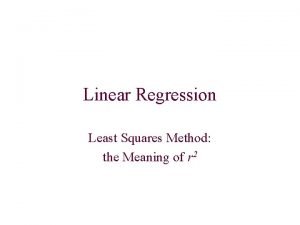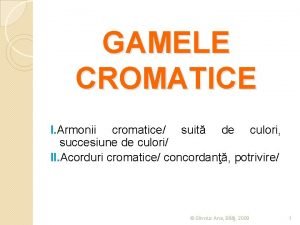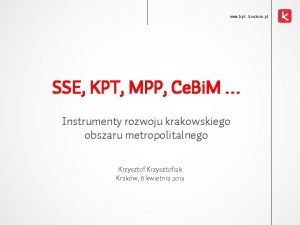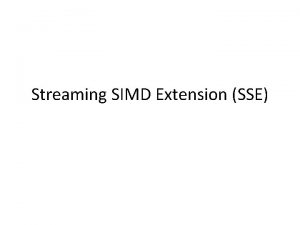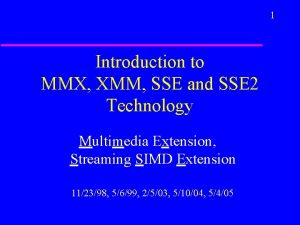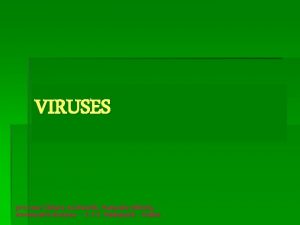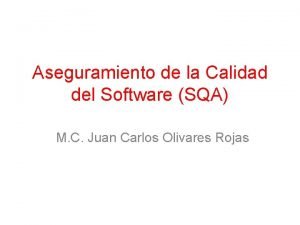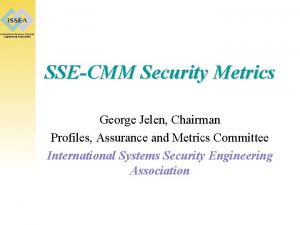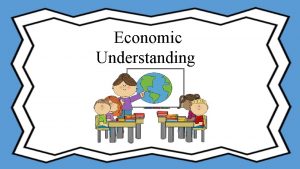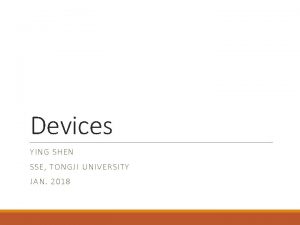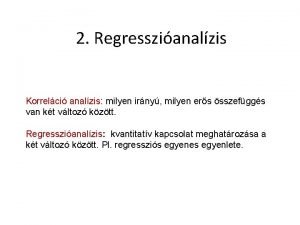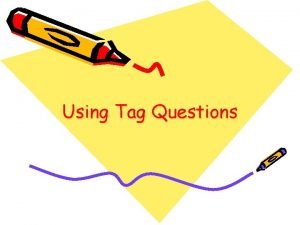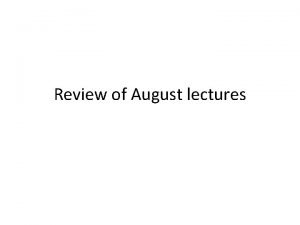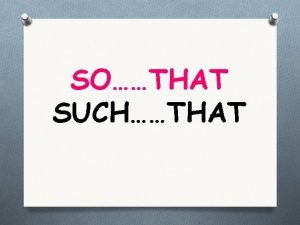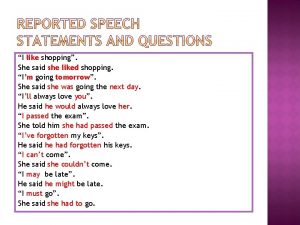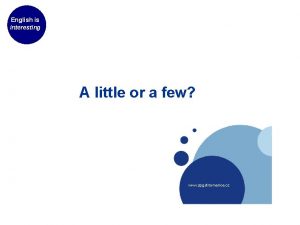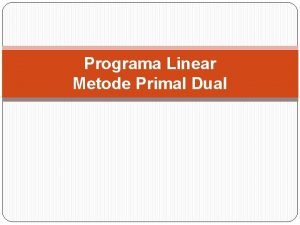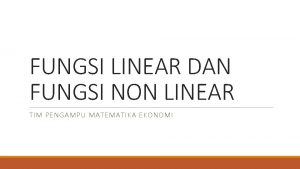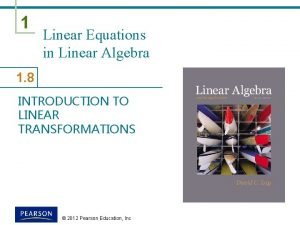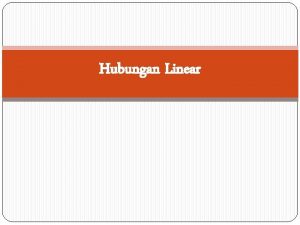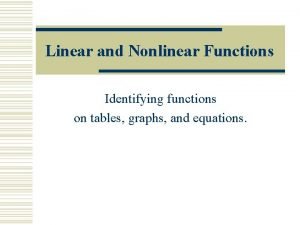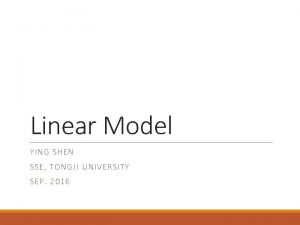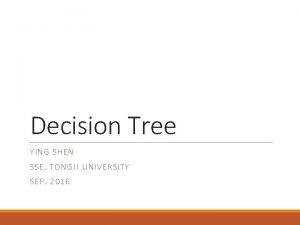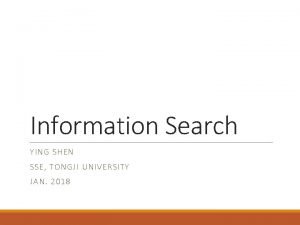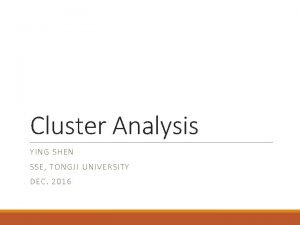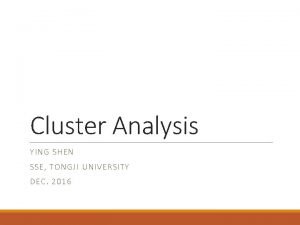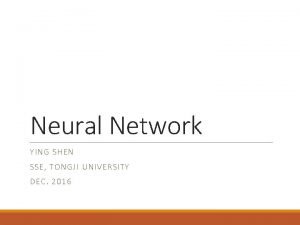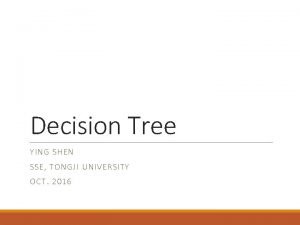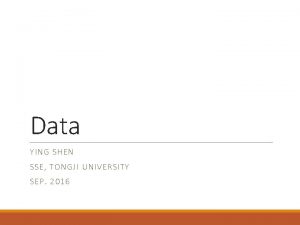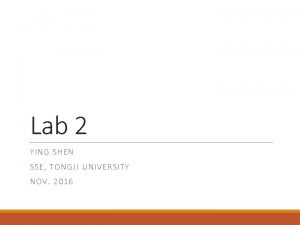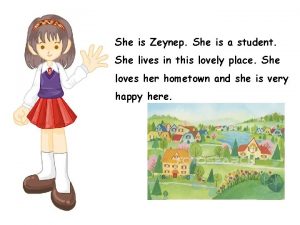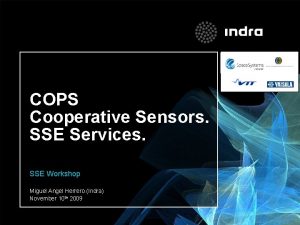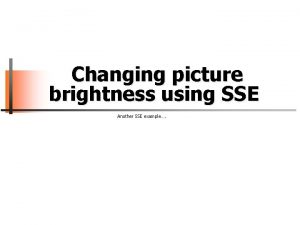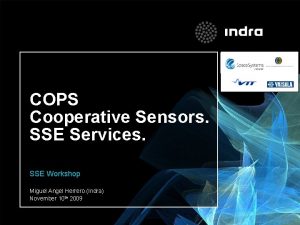Linear Model YI NG SHE N SSE TON


















































- Slides: 50

Linear Model YI NG SHE N SSE, TON GJI UNIVERSITY SEP. 2016

The basic form of the linear model 10/28/2020 PATTERN RECOGNITION 2

Linear regression Hours Spent Studying Math SAT Score 10/28/2020 4 9 10 14 4 7 12 22 1 3 8 390 580 650 730 410 530 600 790 350 400 590 PATTERN RECOGNITION 3

Linear regression 10/28/2020 PATTERN RECOGNITION 4

Linear regression Mean squared error (MSE) is a commonly used performance measure: We want to minimize MSE between f(xi) and yi: 10/28/2020 PATTERN RECOGNITION 5

Linear regression The method of determining the fitting model based on MSE is called the least square method In linear regression problem, the least square method aims to find a line such that the sum of distances of all the samples to it is the smallest. 10/28/2020 PATTERN RECOGNITION 6

Pre-requisite A stationary point of a differentiable function of one variable is a point of the domain of the function where the derivative is zero Single-variable function: f(x) is differentiable in (a, b). At x 0, Two-variables function: f(x, y) is differentiable in its domain. At (x 0, y 0), 10/28/2020 PATTERN RECOGNITION 7

Pre-requisite 10/28/2020 PATTERN RECOGNITION 8

Parameter estimation 10/28/2020 PATTERN RECOGNITION 9

Parameter estimation 10/28/2020 PATTERN RECOGNITION 10

Multivariate linear regression 10/28/2020 PATTERN RECOGNITION 11

Pre-requisite 10/28/2020 PATTERN RECOGNITION 12

Pre-requisite Matrix differentiation 2. Function is a matrix and the variable is a scalar Definition 10/28/2020 PATTERN RECOGNITION 13

Pre-requisite Matrix differentiation 3. Function is a scalar and the variable is a vector Definition In a similar way 10/28/2020 PATTERN RECOGNITION 14

Pre-requisite Matrix differentiation 4. Function is a vector and the variable is a vector Definition 10/28/2020 PATTERN RECOGNITION 15

Pre-requisite Matrix differentiation 5. Function is a vector and the variable is a vector In a similar way 10/28/2020 PATTERN RECOGNITION 16

Pre-requisite Matrix differentiation 5. Function is a vector and the variable is a vector Example 10/28/2020 PATTERN RECOGNITION 17

Pre-requisite 10/28/2020 PATTERN RECOGNITION 18

Pre-requisite 10/28/2020 PATTERN RECOGNITION 19

Multivariate linear regression 10/28/2020 PATTERN RECOGNITION 20

Multivariate linear regression 10/28/2020 PATTERN RECOGNITION 21

Generalized linear model 10/28/2020 PATTERN RECOGNITION 22

Logistic regression 10/28/2020 PATTERN RECOGNITION 23

Logistic regression 10/28/2020 PATTERN RECOGNITION 24

Logistic regression 10/28/2020 PATTERN RECOGNITION 25

Logistic regression Task: Determine w and b in Solution: 1. y → p ( y = 1 | x ) 2. Estimate w and b using maximum likelihood method 10/28/2020 PATTERN RECOGNITION 26

Pre-requisite: maximum likelihood estimation 10/28/2020 PATTERN RECOGNITION 27

Pre-requisite: maximum likelihood estimation 10/28/2020 PATTERN RECOGNITION 28

Pre-requisite: maximum likelihood estimation 10/28/2020 PATTERN RECOGNITION 29

Logistic regression 10/28/2020 PATTERN RECOGNITION 30

Logistic regression 10/28/2020 PATTERN RECOGNITION 31

Pre-requisite: Newton’s method was first published in 1685 in A Treatise of Algebra both Historical and Practical by John Wallis. In 1690, Joseph Raphson published a simplified description in Analysis aequationum universalis. 10/28/2020 PATTERN RECOGNITION 32

Pre-requisite: Newton’s method 10/28/2020 PATTERN RECOGNITION 33

Pre-requisite: Newton’s method 10/28/2020 PATTERN RECOGNITION 34

Logistic regression 10/28/2020 PATTERN RECOGNITION 35

Logistic regression The first and second derivatives of are given in the book Assignment 1: Implemented logistic regression model using matlab (R, Python, or any language you are familiar) You can use any dataset in UCI repository to validate your model Plot a figure like this → 10/28/2020 PATTERN RECOGNITION 36

Pre-requisite: Lagrange multiplier 10/28/2020 PATTERN RECOGNITION 37

Pre-requisite: Lagrange multiplier n+m equations! 10/28/2020 PATTERN RECOGNITION 38

Pre-requisite: Lagrange multiplier 10/28/2020 PATTERN RECOGNITION 39

Pre-requisite: Lagrange multiplier 10/28/2020 PATTERN RECOGNITION 40

Linear discriminant analysis In a two-classification problem, given n samples in a ddimensional feature space. There are n 1 samples belong to class 1 and n 2 samples belong to class 2. Goal: to find a vector w, and project the n samples on the axis y = w. Tx, so that the projected samples are well separated. 10/28/2020 PATTERN RECOGNITION 41

Linear discriminant analysis 10/28/2020 PATTERN RECOGNITION 42

Linear discriminant analysis 10/28/2020 PATTERN RECOGNITION 43

Linear discriminant analysis 10/28/2020 PATTERN RECOGNITION 44

Linear discriminant analysis 10/28/2020 PATTERN RECOGNITION 45

Multiclassification Ov. O “+” “-” C 1 C 2 C 1 C 3 C 1 C 4 C 2 C 3 C 2 C 4 C 3 C 4 10/28/2020 C 1 C 2 C 3 C 4 Ov. R “+” “-” C 1 C 2 C 3 C 4 “-” C 2 C 1 C 3 C 4 “-” C 3 C 1 C 2 C 4 “+” C 4 C 1 C 2 C 3 “-” N(N-1)/2 classifiers PATTERN RECOGNITION 46

Multiclassification Hamming distance test sample 10/28/2020 -1 +1 +1 +1 -1 -1 +1 +1 -1 -1 +1 PATTERN RECOGNITION Euclidian distance 47

Class-imbalance 10/28/2020 PATTERN RECOGNITION 48

Class-imbalance 10/28/2020 PATTERN RECOGNITION 49

Class-imbalance Undersampling Oversampling Threshold-moving 10/28/2020 PATTERN RECOGNITION 50
 Sse linear regression
Sse linear regression Que ton aliment soit ton médicament
Que ton aliment soit ton médicament Gama ton in ton pictura
Gama ton in ton pictura 0 856m = cm
0 856m = cm Angka banding togel
Angka banding togel Mpp kraków
Mpp kraków Sse simd
Sse simd Mmx sse
Mmx sse Prof.sse
Prof.sse Steven smolders
Steven smolders Sse-cmm
Sse-cmm Introduction to xamarin
Introduction to xamarin Avx sse
Avx sse Sse-cmm
Sse-cmm Trade and barter sse
Trade and barter sse Sse can never be
Sse can never be Direct control pointing devices
Direct control pointing devices Ssr sst sse
Ssr sst sse She is beautiful question tag
She is beautiful question tag I had breakfast before i went to school
I had breakfast before i went to school Who she is or who is she
Who she is or who is she Who was she? where was she? what was happening?
Who was she? where was she? what was happening? Pack she back to she ma
Pack she back to she ma She looks pretty sick. i think she go to a doctor
She looks pretty sick. i think she go to a doctor Finally got a job
Finally got a job She worked hard. she made herself ill
She worked hard. she made herself ill I like shopping
I like shopping Adverb little
Adverb little Linear and transactional models of communication
Linear and transactional models of communication Metode primal dual dapat d diselesainakan dengan
Metode primal dual dapat d diselesainakan dengan Simple linear regression and multiple regression
Simple linear regression and multiple regression Contoh soal persamaan non linier metode biseksi
Contoh soal persamaan non linier metode biseksi Types of text linear text
Types of text linear text What is non-linear plot
What is non-linear plot Contoh soal metode iterasi sederhana
Contoh soal metode iterasi sederhana Linear pipeline processors
Linear pipeline processors Multimedia linear and nonlinear
Multimedia linear and nonlinear Right linear grammar and left linear grammar
Right linear grammar and left linear grammar Perbedaan fungsi linier dan non linier
Perbedaan fungsi linier dan non linier Perbedaan fungsi linear dan nonlinear
Perbedaan fungsi linear dan nonlinear Conditions for linear independence
Conditions for linear independence Linear algebra linear transformation
Linear algebra linear transformation Cara koordinat lereng
Cara koordinat lereng Principle of linear impulse and momentum
Principle of linear impulse and momentum Persamaan linier simultan
Persamaan linier simultan Nonlinear function table
Nonlinear function table Linear and nonlinear tables
Linear and nonlinear tables Differences between linear and nonlinear equations
Differences between linear and nonlinear equations Linear and nonlinear editing
Linear and nonlinear editing Metode gauss naif
Metode gauss naif Right linear grammar to left linear grammar
Right linear grammar to left linear grammar
